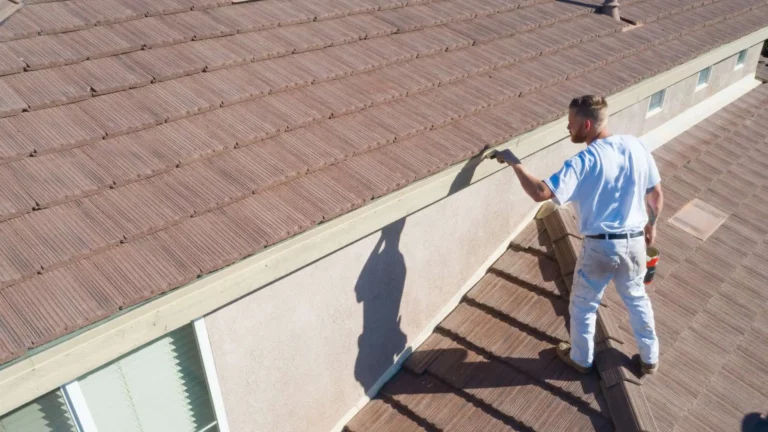One of the fastest ways to renovate and change your home settings is by painting it, but did you know painting can be expensive? In the U.S., painting walls, rooms or the whole house will cost an average of $600-$1000. The costs can vary depending on the paint products, rooms and professional charges. Before you decide to paint your home, set aside a budget. Stick to the budget, as it will help you save money. Look for budget-friendly options to save money on paints, have a color palate or scheme, compare prices, check for deals and discounts or try DIYing it!
Best 25 Ways to Save Money on Paint
Painting is costly, whether for a wall, a room or your home. Here are 25 ways to save money on paint to avoid wasting too much money on paint.
Calculate Needs Accurately
Before you start painting, measure each room and calculate and estimate the number of cans and brushes you might need. Refrain from overbuying or overspending on too many paint cans. Calculate the exact number of materials needed and then purchase them.
Use a Paint Calculator
Use the paint calculator to help you avoid overspending on paint. This tool will help you measure the paint area and wall space and can help you limit your materials. You can also check how many coats you need to apply, whether a primer combination is needed, or what color to pick. A paint calculator will give you precise data about the paints you need. If you plan on painting an ample space, buy paint in bulk and save money.
Choose Quality Over Quantity
Don’t compromise on quality. Though good-quality paints are long-lasting, they need many coats for better results. Quality doesn’t have to be based on brand names; look out for many generic versions that give the same quality and finesse. Select eco-friendly paints that can withstand environmental factors, don’t stain, and are easy to wash or wipe. Make sure this one-time investment will be worth it in the long run, so choose quality over quantity.
Wait for Sales
Don’t miss out on sales! Big paint stores offer sales during certain times of the year. Most of the home setups and progress occur during early spring. At this time, you might find a series of sales and deals. Use social media, follow pages, keep track, and stay updated about sales and special promotions these stores offer. Shopping during this time can help you save money and get your paint cans for a lower price.
Buy Mis-tinted Paint
Also known as ‘Oops’ or recycled paint, these paints are wonderful. Mis-tinted paints are available for almost 50-75% less in price. A gallon of mistinted paint can cost between $5-$10, and smaller sizes are available at $1-$2.50. Almost all brands are priced in the same range. These paints are resourceful, give a metallic look and are eco-friendly. Look out at stores for these paints to get them at a price and save money. You can use mis-tints to paint your furniture, art and picture frames.
Check Recycling Centers
Don’t waste or throw away extra paint. It can be recycled and reused. Recycling paint can save you thousands of dollars and prevent the use of hazardous products. Some centers take the initiative to recycle paint and help protect the environment. Getting paints from these centers will help you decorate your home with less money.
Purchase Returned Paint
Instead of buying new paint buckets, visit the nearby hardware shop and look for returned paint cans. These paint cans will be available for less and with discounts, as customers have left them behind because they weren’t happy with the mixed colors or the finishing wasn’t fine.
Use Leftover Paint
If you want to paint every room different colors, reuse leftover paint in different spaces. By doing so, you are saving money and trying to get creative. Try playing with colors, giving different shades, designs, and outlines to give a unified look. Though paints have expiry dates, paint supplies like rollers, brushes, tarps, tapes, and more can be reused again and again.
Apply Primer
Primers are usually cheaper than most paints and can save two coats of paint. This is mainly used if you’re painting on a new surface or changing colors completely. Most self-priming paints give good results and usually don’t require buying a primer. If you’re replacing a dark color with a light one, using an inexpensive primer will help you save money. Purchase a can of primer, use it as a first layer, and then add one or two layers of paint on top of that.
Opt for All-In-One Paint
An all-in-one paint is a combination of primer, paint, and topcoat. These paints are high-quality, long-lasting, and durable. Most products usually tell how many coats are needed for optimal priming, durability, and coverage. Using these high-quality paints that last a long time will help you save money. These paints are usually used to paint furniture to make it look classy, neat, and new!
Join Loyalty Programs
Most paint brands and stores, online and offline, offer their customers loyalty programs. These programs help members get updates on sales, promotions, discounts, and deals on paints. Members might also have benefits, earn points or rewards, and save money.
Buy in Bulk
Be it groceries, clothes or paints, buying in bulk can save you a lot of money. If you’re painting more than just one wall or areas that need repainting, it’s best to buy paints in bulk. Painting them with the same color can save you money buying bulk cans. You can buy a 5-gallon bucket instead of just one or two. Save money by combining projects with friends, neighbors or family members.
Look for Manufacturer Rebates
These are financial incentives offered by manufacturers to customers after purchase. This is a financial strategy that encourages customers to buy more of these products. Rebates are a partial refund on the cost of an item. To take advantage of such offers, start looking for stores that offer manufacturer rebates. If you find paint stores that have this option, use it and save money.
Choose Multi-Surface Paint
This type of painting is time-saving and cost-effective as these products have been made to help people save money on paints. These paints help cover any surface with one type of paint. They can be used on walls, ceilings, wood, metal, plastic, tiles, frames, ornaments and radiators. Using multi-surface paint can help you cover most of the areas at home with less cost. These paints are environmentally friendly; you don’t need a primer or undercoat, are flexible, and resist peeling or flaking.
Borrow Tools
Avoid buying tools every time you decide to paint. Check with friends or neighbors if they’ve tools and supplies, you can borrow them. Brushes, rollers, tapes, paint sprayers, ladders and others can be borrowed, rented, used and returned. By doing this you will save a lot of money, especially when it’s a one-time use. Look for nearby hardware stores and paint shops online or offline that give tools on rent.
Do It Yourself
Become a DIYer, get creative and paint your walls with your favorite colors! Work with dedication, stay organized, start slow, go from one room to the next, take proper measurements, and do smooth, even rolls. Before you start, have a clear picture of how you want things to be done and specific colors for rooms, designs, and décor.
Prep Well
Make sure you prep the walls well before starting to paint. Create a proper space, use the painter’s tape, measure correctly, cover doorknobs and floors, remove switch covers and outlet plates, look up videos on how to prepare your home, plan well, and execute it. Getting paint anywhere can be messy, and you might spend money on buying new hardware.
Seal Leftover Paint
Storing paint is important, especially if you have leftovers and would like to use them in the future. Reusing leftover paints is economical and can save money. According to experts, the shelf life of paints once opened is two years. Environmental and other factors can cause fluctuations. The paint cans must be airtight, with plastic wrap placed between the lid and the opening. Ensure you store the paint cans in a dry place and away from direct sunlight.
Buy No-VOC Paint
No-VOC paints have few or no volatile organic compounds. Some might contain traces of dangerous chemicals. The standard usage of these products is less than 5 grams per liter of paint. Zero, no, or low-VOC paints can be better for those who have health concerns as they have few VOCs, but they can still carry toxic ingredients. A much better alternative is to look for paints that have non-toxic or natural labels on them.
Utilize Swaps
You can swap paints with friends, family members, or your neighbors. Not just paint, you can exchange supplies too. Also, try swapping colors to make new shades between the design and the background. This way, you will use minimal paint and decorate your rooms more colorfully.
Get Professional Discounts
If you have a big area to paint and want professional help, check pricing and discounts with the. Professionals and contractors have different discounts and prices. These discounts can be available in stores or online too. Keep track of them and get a 15-20% discount on paints.
Negotiate Prices
It’s time to use your bargaining skills and negotiate prices. Start by calculating how much you will need for each room or wall you wish to paint. If you know people who have hired painters before, inquire about the costs, shop around, look for quotes, and compare costs with your set budget. If it fits within the range, then go for it; otherwise, be polite in negotiating costs.
Use Less
While selecting paints, choose colors wisely. You can take contrast on walls, minimize the number of paint cans needed, or try different shades by mixing colors. Use a color palate before you get started. Selecting one color will get the work done quicker and easier. Don’t use dark colors on walls; use them as border lines, trimmings, or accents.
Restore Instead of Replace
If you notice your walls need repainting, touch-ups, or patchwork, don’t invest in new paint. Use paint that has been airtight and sealed properly. In case the paint has dried, use a thinner for better results. Mix the paint well so all the elements blend well.
Follow Sales on Social Media
Social media is a good platform and a great source for knowing about sales and paint prices. You can follow online stores and check for seasonal sales, promotions, or deals. You can also be part of their loyalty programs.
Conclusion
Painting your home or furniture is expensive yet fun. Save money on paint. The 25 budget-friendly ways mentioned above will help you save money on paints and adorn your home with your favorite colors. Before you start painting, have a sketch of how you want things to be, set a budget, shop around, compare prices, plan well, choose the right colors and enjoy painting your home. For further financial insights and recommendations, use Beem to save and plan your money for a more improved financial health.
FAQs
What month does paint usually go on sale?
Paints usually go on sale during the summer months. Paint sales also happen during holidays, such as the weekend of Memorial Day, Labor Day, and the 4th of July. Specific stores have sales at different times of the year.
Is it cheaper to buy paint in 5 gallons?
Yes, buying 5 gallons of paint is cheaper than buying five one-gallon cans of the same product. Buying paint in bulk will help you save money.
Why does paint cost so much?
Many factors make paint expensive, including the use and rise of raw materials costs, paint technology for good quality and durability, and the effect of supplying it globally.






























